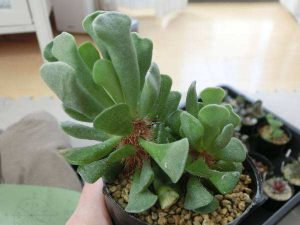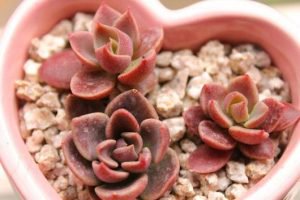Plant growth habits and conservation focus on succulent plants-the shape, habits and conservation focus of fantasy!
Succulent plants-the form, habit and conservation focus of the fantasy!
English name: fantasy
Another name: fantasy.
Latin scientific name: Adromischus poellnitzianus
Family and genus: Sedum family
Distribution of origin: South Africa
Tianjinzhang of crassulaceae is a succulent plant native to Western Cape Town, South Africa, and is a perennial herb of the genus Rhodiola. The axe-shaped leaf blade is highly succulent, the leaf margin is round and obtuse and wavy, and the leaves are green or with light brown markings. The stem is thick and short, with many hairy aerial roots protruding. There are many changes in individual appearance, with white leaf margin, obvious markings or undeveloped aerial roots on the stem. Like the sunny and cool, dry environment, no obvious dormancy period.

The growth habit of the fantasy
Like the sunny and cool, dry environment, no obvious dormancy period. Key points of cultivation: the suitable temperature for growth is 15-25 degrees, and not less than 7 degrees in winter; the soil can be mixed with rotten leaf soil, vermiculite, coarse sand or perlite, plus a small amount of plant ash and bone powder; the growing period is watered dry and thoroughly; fertilization is usually applied every 20 days or so. In addition to the high temperature in summer, cutting propagation can be carried out above 10 degrees. Strong and substantial leaves can be selected and hung flat on the soil for 1-2 days. They will soon take root and sprout, but they should not be transplanted prematurely.
Fantasy song, the leaf is longer than the Tianzhang leaf, the leaf apex has no ripple, the stem brown is wrapped by dense aerial root, the posture is strange. Fantasy prefers a sunny, cool, dry environment with no obvious dormancy period. Key points of cultivation: the suitable temperature for growth is 15-25 degrees, and not less than 7 degrees in winter; the soil can be mixed with rotten leaf soil, vermiculite, coarse sand or perlite, plus a small amount of plant ash and bone powder; the growing period is watered dry and thoroughly; fertilization is usually applied every 20 days or so.
The propagation method of the fantasy.
The suitable temperature for the growth of Shenxiqu is 15-25 degrees, and not less than 7 degrees in winter; generally, the mixed soil can be mixed with rotten leaf soil, vermiculite, coarse sand or perlite, plus a small amount of plant ash and bone powder; the growing period is watered dry and thoroughly; fertilization is usually applied every 20 days or so. Leaves can be used for propagation, except for high temperature in summer, more than 10 degrees can be carried out. Strong and full leaves can be selected and hung flat on the soil for 1-2 days. They will soon take root and sprout, but they should not be transplanted prematurely.
The reproduction of Shenyuqu can be cut by leaves, which are longer than Tianzhang leaves, have no ripples at the apex, and have a peculiar posture when the stem is brown wrapped by dense aerial roots. It doesn't bloom. Leaves can be used for propagation, except for high temperature in summer, more than 10 degrees can be carried out. Strong and full leaves can be selected and hung flat on the soil for 1-2 days. They will soon take root and sprout, but they should not be transplanted prematurely.
- Prev

Succulent plants-due to the shape, habits and conservation priorities of local cards! Cultivation and growth environment
Succulent plants-due to the shape, habits and conservation priorities of local cards! English name: Indica alias: Moxin Latin name: Sinocrassla indca family genus: sedum family distribution: South Africa Indica, a perennial succulent plant also known as Moxin
- Next

Growth habits and maintenance precautions of green flowers and thousands of rabbit ears
English name: thousand-eared rabbit Latin name: Kalanchoemillotii Family: Sedum koja thousands of rabbit ears furry hair and half-jaw leaves will produce small buds in the gap. Thousands of rabbit ear branches are easily lignified and can pass through water.
Related
- Fuxing push coffee new agricultural production and marketing class: lack of small-scale processing plants
- Jujube rice field leisure farm deep ploughing Yilan for five years to create a space for organic food and play
- Nongyu Farm-A trial of organic papaya for brave women with advanced technology
- Four points for attention in the prevention and control of diseases and insect pests of edible fungi
- How to add nutrient solution to Edible Fungi
- Is there any good way to control edible fungus mites?
- Open Inoculation Technology of Edible Fungi
- Is there any clever way to use fertilizer for edible fungus in winter?
- What agents are used to kill the pathogens of edible fungi in the mushroom shed?
- Rapid drying of Edible Fungi

